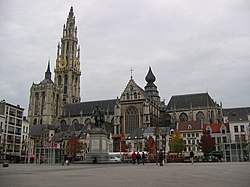Henry Bredemers
Henry Bredemers | |
|---|---|
| Born | 1472 |
| Origin | Netherland |
| Died | May 20, 1522 |
| Occupation(s) | Organist and Music teacher. |

Henry (Henri, Hendrik) Bredemers (Bredeniers) (c. 1472 – May 20, 1522) was a South Netherlandish organist and music teacher. No compositions by him survive, and his historical importance lies chiefly in his activities as a teacher.
The first recorded reference to Bredemers is in a 1488 document which lists him as one of the singers of
The chapel, known then as Grande chapelle, was the main musical establishment of the Burgundian-Habsburg court, and one of the most important court chapels of the Renaissance: it had a long and illustrious history associated with composers of the

When Philip died in 1506 at
Bredemers' influence was spread far by Philip's children. Isabella's lessons came to an end in 1514 when she married
No compositions by Bredemers are known, although two were mentioned by Fétis[1] in his Biographie universelle in the second half of the 19th century. Bredemers' importance lies in the influence he must have exerted over European keyboard music during his voyages to Spain, England and Germany, as well as through his pupils.[4]
Notes
References
- Brauchli, Bernard. 1998. The Clavichord, Cambridge University Press, ISBN 978-0-521-63067-2
- Keyl, Stephen Mark. 1989. Arnolt Schlick and Instrumental Music circa 1500. Diss. Duke University.
- Picker, Martin (2001). "Henry Bredemers". In ISBN 978-1-56159-239-5.
